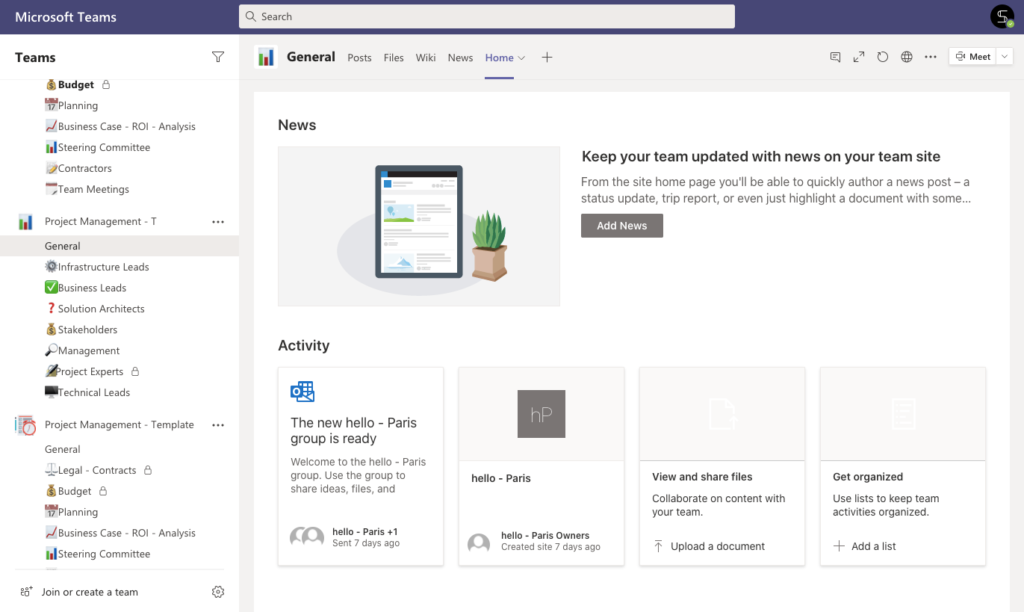We’ve all worked with intranets and with SharePoint. SharePoint offers great capabilities in terms of structured collaboration and information management at scale. As a part of Microsoft products, SharePoint allows you to integrate many different software that you usually use in your daily work. In this article we will talk about SharePoint features and its integration with Microsoft Teams and other software.
What is SharePoint used for?
SharePoint is an indispensable application for those who want to easily organize their workspace and keep all the details necessary for work in one place. Just imagine, with the help of SharePoint, you can create your own Site with open access for your entire organization in a few steps. With SharePoint, you can easily group the necessary information, share files, follow the news, and have quick access to the latest changes online.
Let’s have a look at all the features of SharePoint.
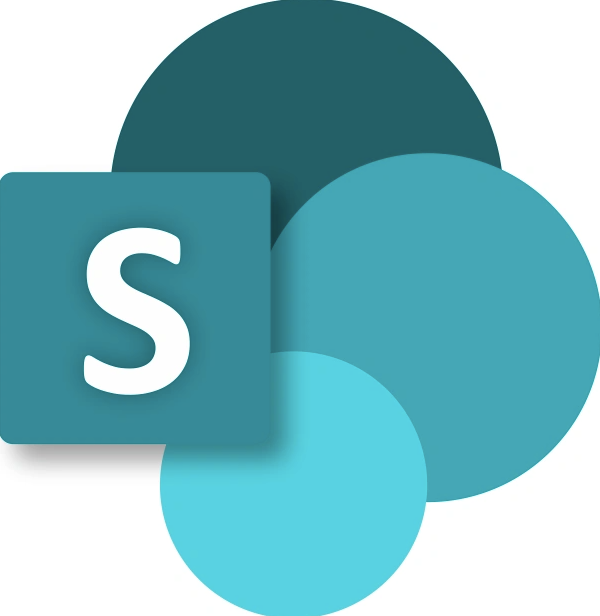
The goal of implementing SharePoint in a company is to optimize work processes, and save employees’ time and resources. Let’s see how this effect is achieved. Here is just a small list of the results that can be achieved through the competent use of the corporate portal SharePoint:
- Employees get the opportunity to work together. This is facilitated by the rapid exchange of documents, news, links, and other resources, as well as the optimization of communication processes;
- Convenient access to corporate information is organized. Employees do not have to spend their time looking for a necessary document, a table with analytical data, training materials, or contacts of the right people;
- The workflow is reduced and systematized;
- The structure of the enterprise acquires transparency, it becomes clear to everyone – from “old-timers” of the company to new hires. Due to this, the adaptation of beginners is easier;
- The problems of control over the fulfillment of tasks are being solved. With the help of lists, you can register any changes and quickly monitor the status of work issues;
- Communication between employees on work issues is being established: using SharePoint tools (discussion boards on group sites, comments in blogs, etc.), a convenient environment for intra-corporate communication is created, although this is not a full-fledged social network.
SharePoint key features
While you are connecting through a web browser or mobile application, you will see a convenient interface SharePoint, to which you belong according to your Office 365 environment. Here you can see the news – these are posts, sites, and discussions that have been published by your colleagues. You can also check the latest sites you have visited. In addition, it is very convenient to follow your preferred topics that you have marked as favorites.
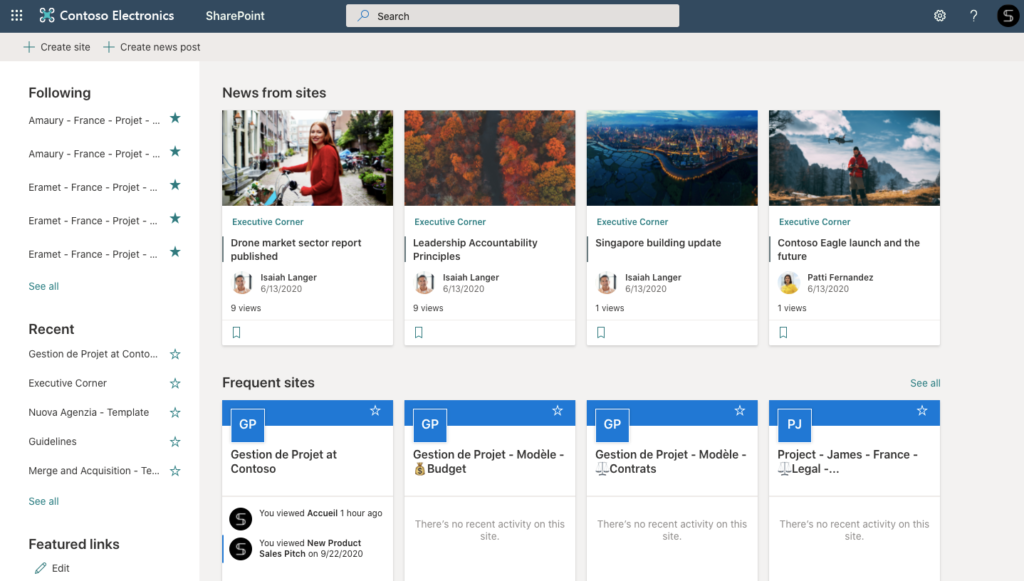
You can also use the Search bar to look for any interesting site or page. In one click, you can publish a post in which you can add not only your comments but also support documents, images, videos, links – everything that you would like to share within your organization and team. Similarly, you can create a new site. Let’s stop at this part and consider all the possibilities in more detail.
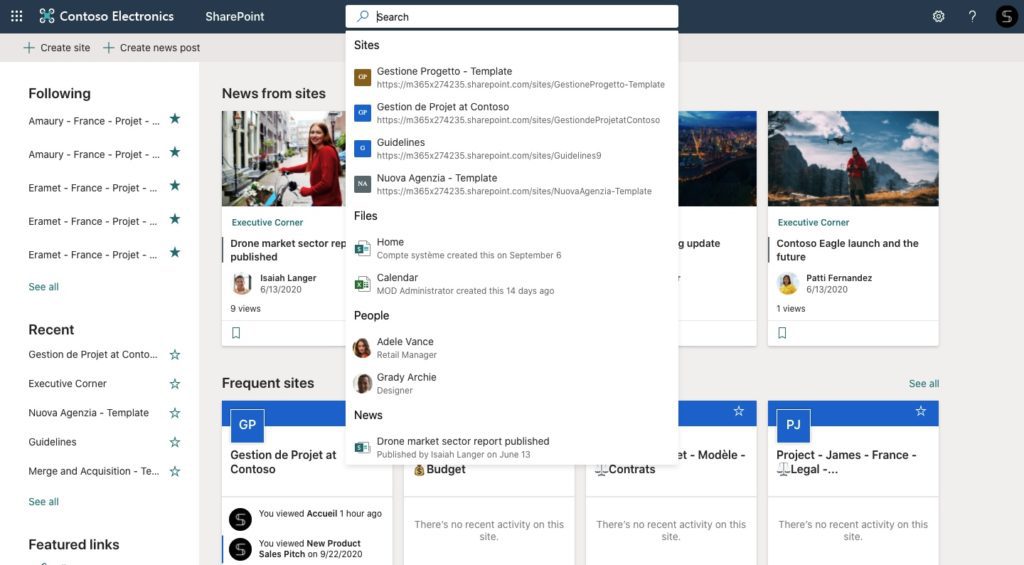
How to create SharePoint Sites?
Before building a new site, let’s understand the basic structure of any SharePoint intranet. This intranet is made by several independent Sites, collecting pages, news, documents, and anything you need to share inside your company. These Sites can also include Subsites showing other content with dedicated options. When you decide to create a new Site, you will see two main kinds of sites: The Communication Sites and a Teams Site.
Communication Sites
The Communication Sites have a modern visual layout used to communicate and share news and events with a large audience. During the creation of a new Communication Site, you should define the site name, address, description, and default language. You can also choose the kind of template to use it for a site design.
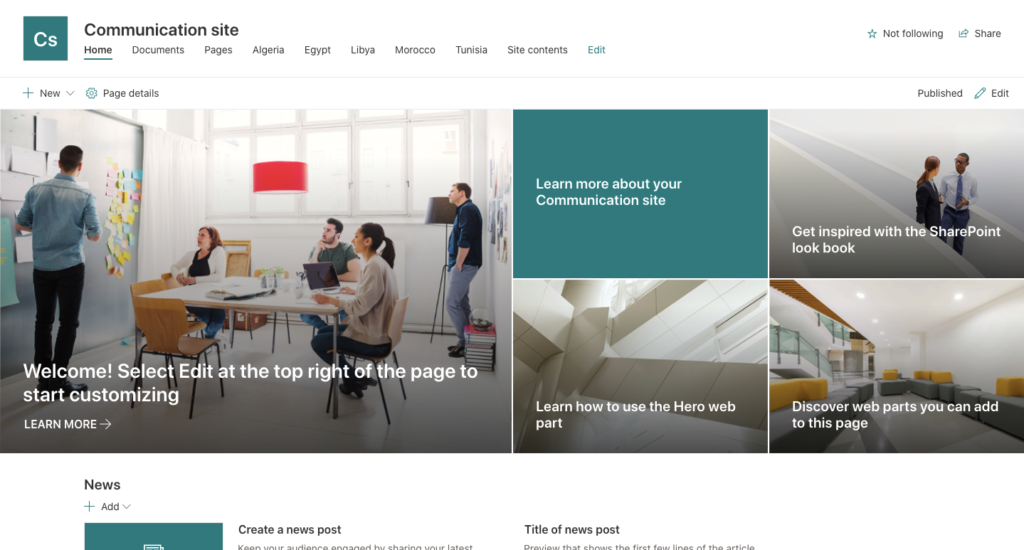
After creation of the new Communication Site, you will see a nice layout showing links to pages, new posts, organization events, and shared documents. You can share this site to invite and give access to people, Office group, or even everyone inside your organization.
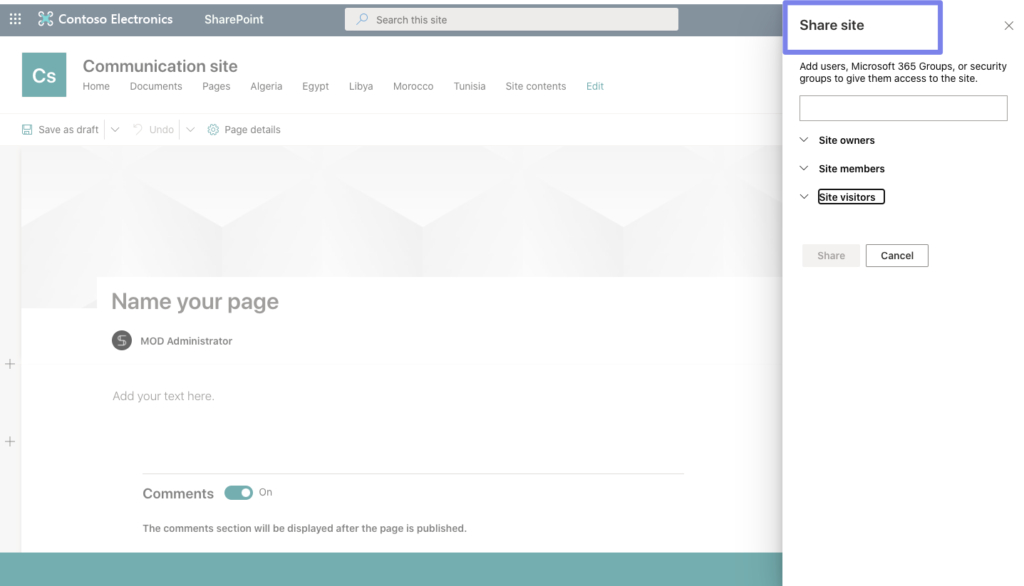
Next, you can manage the Site permissions with the deep rules of access in the Site settings. By default only you have access to the site, being one of the Site Owners that have full control over the site content and layout? You also have Site members that can view, edit, and moderate the site content and Site visitors which can just read and download content from your site. If you go to Advanced permissions settings, you will manage all the possible actions that Owners, Members, and Visitors can perform.
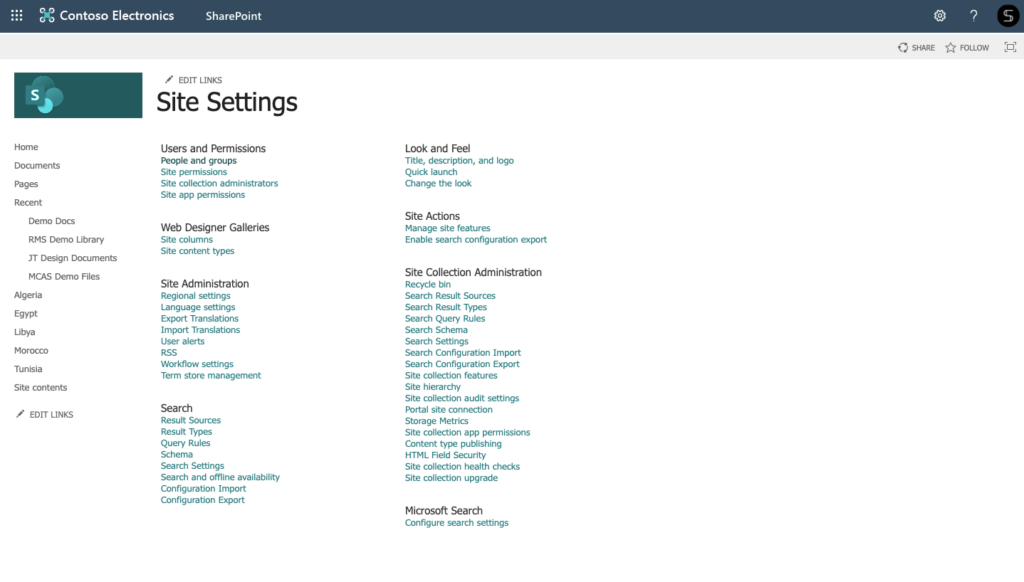
Team Sites
The Team Site is another type of site that allows getting major control over privacy and permissions on the site content. It can be public or private and is used to share information and make collaborations on projects between all the users approved on a defined Office 365 group chosen for such a Team site.
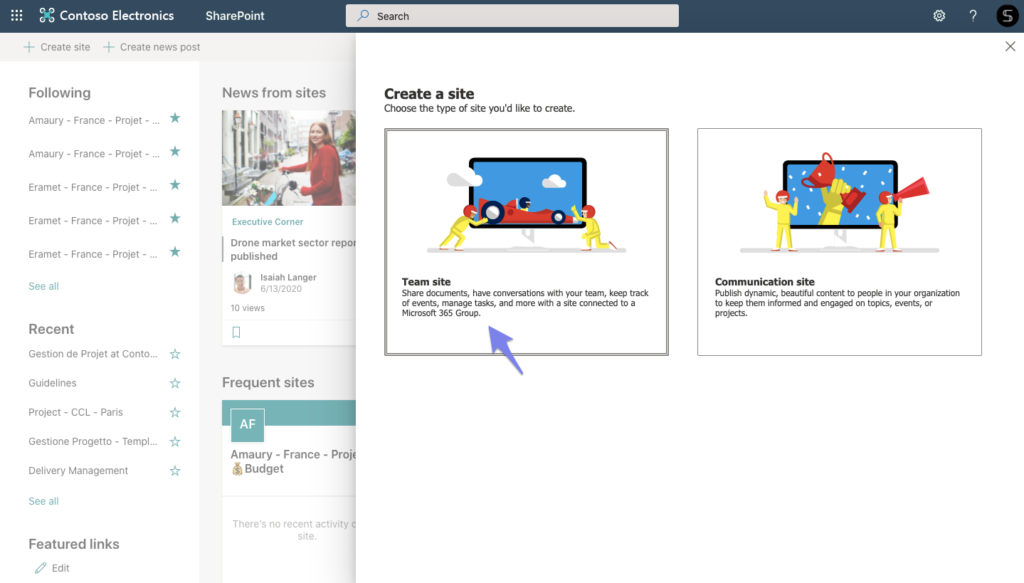
This is recommended for private groups working together that need to share sensitive projects and documents. When creating a Team Site you automatically create a Group email address (or Office 365 group) associated with it that grants access to your new Team site content. In addition, you can also set the Privacy settings: choose Public (to make your Team site accessible by anyone inside your organization or Private (to make it reachable just by users invited and approved as Members by the Team site Owners).
Team Sites can be edited and shared just like Communication Sites. They also have the same settings panel to adjust permissions, reach its content, and change its look. Team Sites can include Site Pages but also Wiki Pages and Web Part Pages. Wiki Pages are simple text pages very useful to share ideas, comments, and knowledge across the Team site group. Whereas Web Part Pages are empty pages you build by adding Web Parts from scratch
The SharePoint intranet can also include site collections, such as subsites referring to the main Communication or Team site more focused on a particular theme. Subsites can either inherit or get their own privacy settings and Office groups independent from the main Site.
What are SharePoint Hub Sites?
Well, you’ve created a SharePoint Site for your organizational intranet. What’s next? As a SharePoint Administrator, you can create different SharePoint Hub Sites. Let’s say a Communication Site that you’ve created before serve your organization as the main page designed to engage users and highlight your brand messaging. Next, it’s time to build Hubs that bring together related content, news, and site activity across all associated sites.
Hubs provide a logical tie between SharePoint Sites. With Hubs, you can provide a unified navigation experience and roll up news and events in a centralized display. Just simply assign your site to a new Hub and your site’s branding is automatically updated.
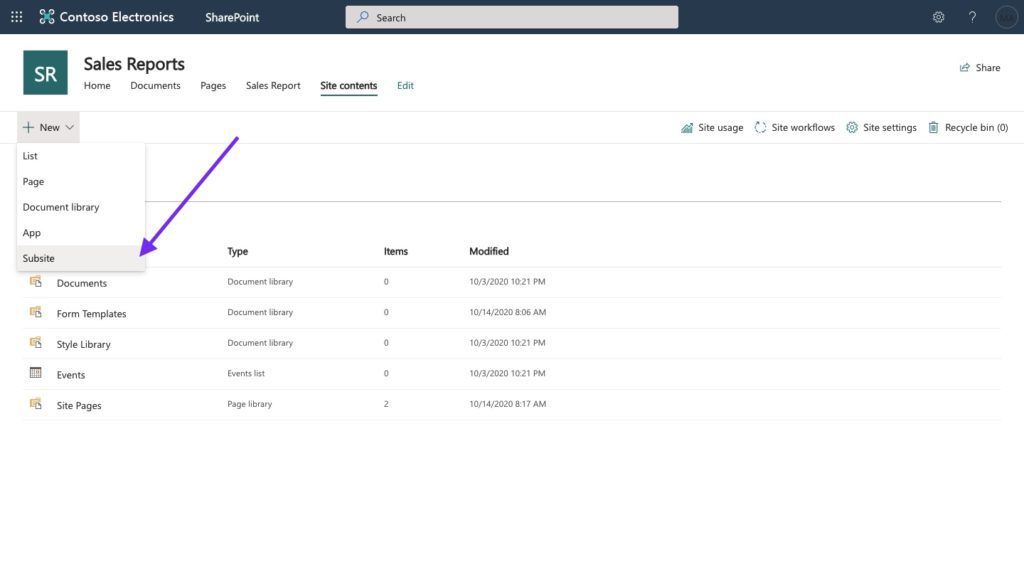
How does it work?
1. As a SharePoint Administrator determine SharePoint Governance Policies. For example, you should set up how many hub sites can be built in your organization, who can associate sites and hub sites, and if it needs to be approved. You can learn more about SharePoint hub Sites Planning here.
2. Share Hub Navigation. As a hub site owner, you’re able to customize the navigation bar. You will see it at the top of a hub site and any associated sites.
3. Add content. Customize your Hub Site with related content:
News Roll-Up. Use News Web Part to publish news in a hub site and on any associated sites. You can choose which associated sites display news on the hub site. What’s important here, is that viewers will only see news they have access to.
Highlighted content. Display content from sites associated with the hub site with the Highlighted content web part
Associated Sites. Use Sites Web Part to pay attention to the most active sites associated with a hub
4. Associate sites to a hub site. You can easily associate sites with hub sites in two ways.
First, you can create a new site by clicking the +Create site on the hub site page. Thus, the new Site will be automatically associated with that hub site
Second, you can associate an existing site to a hub through an approved association flow. In this case, a hub site owner can set up your SharePoint hub site to evaluate requests for sites before the association takes place.
SharePoint integration with other Microsoft apps
To check and manage the content of your site you can go to Site Contents. This collects all the site media, pages, and documents grouped into several kinds of SharePoint apps, such as Document libraries, Event lists, and Page libraries.
Document sharing with OneDrive
The Document libraries list all the media files and documents inside the site, or all the documents created and uploaded by users inside Documents. Inside this library, you can create a new folder, link, or new file. You can also upload any file from your computer. With SharePoint, you can easily download or upload files, as well as edit the document together with your colleagues.
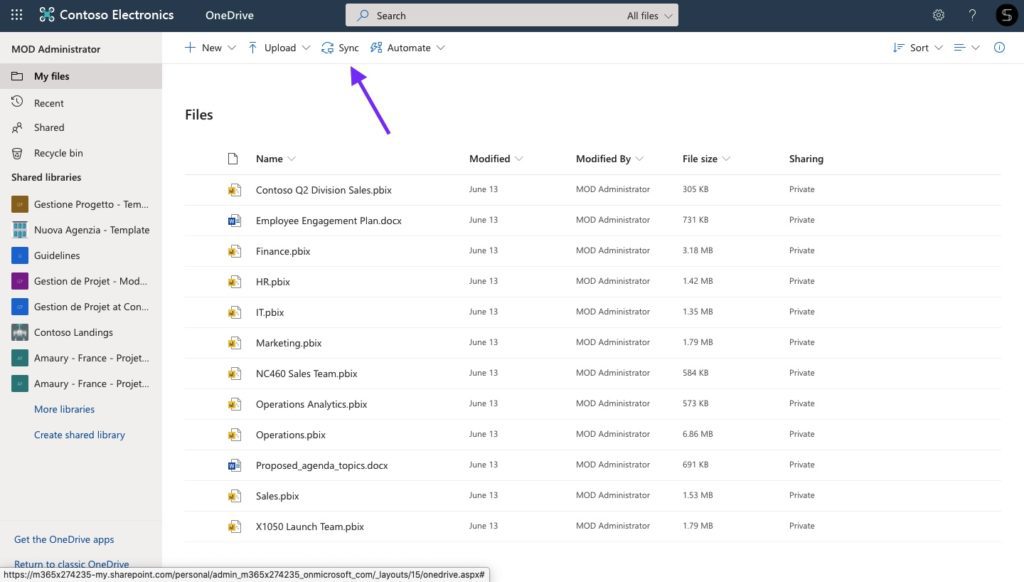
The great integration here is the possibility to sync your SharePoint library with your OneDrive account. In this way, you can download these documents and edit these offline on your device and then resync these on SharePoint once you come back online. Learn how to sync your OneDrive and SharePoint files here.
Power BI reports
You can easily manage and follow the reports through Power BI for SharePoint which makes it easy to add reports securely. During the new page creation inside the SharePoint, you can see the Power BI preview. Just choose the needed report inside your Power BI environment and you will see the option Embed link for SharePoint. It’s done!
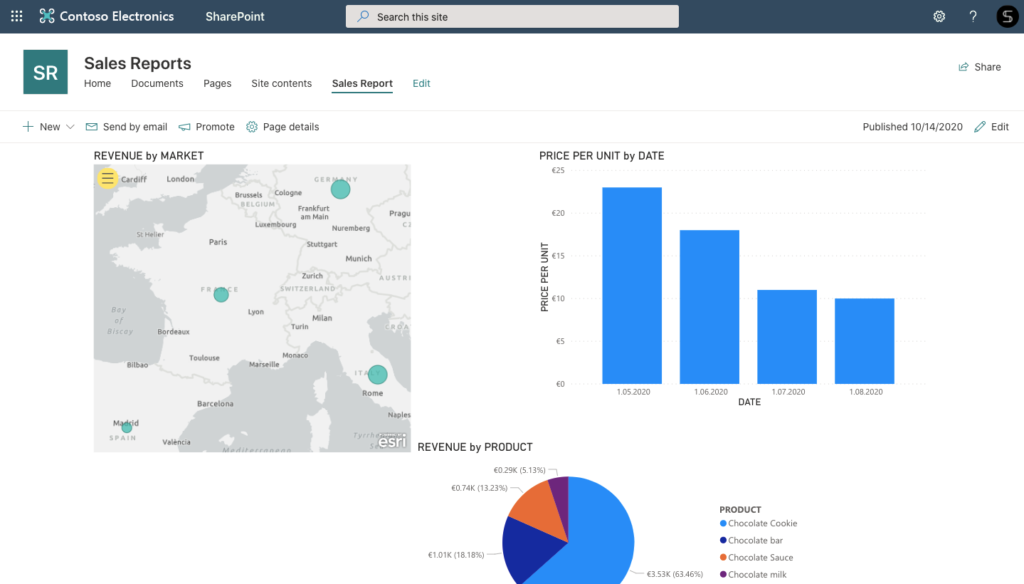
After configuring settings to customize the view you can publish a report. Thus, you can share the latest reports across your organization or private team to keep your colleagues up-to-date. Read more about Power BI and SharePoint here.
Sharing content from Video Stream
As a part of your Site Contents, you can store and share videos through News on your sites. To collaborate effectively and share videos with a broader audience within your organization, you can use the Microsoft Stream. It’s a video service that helps people to upload, view, and share video content across your organization.
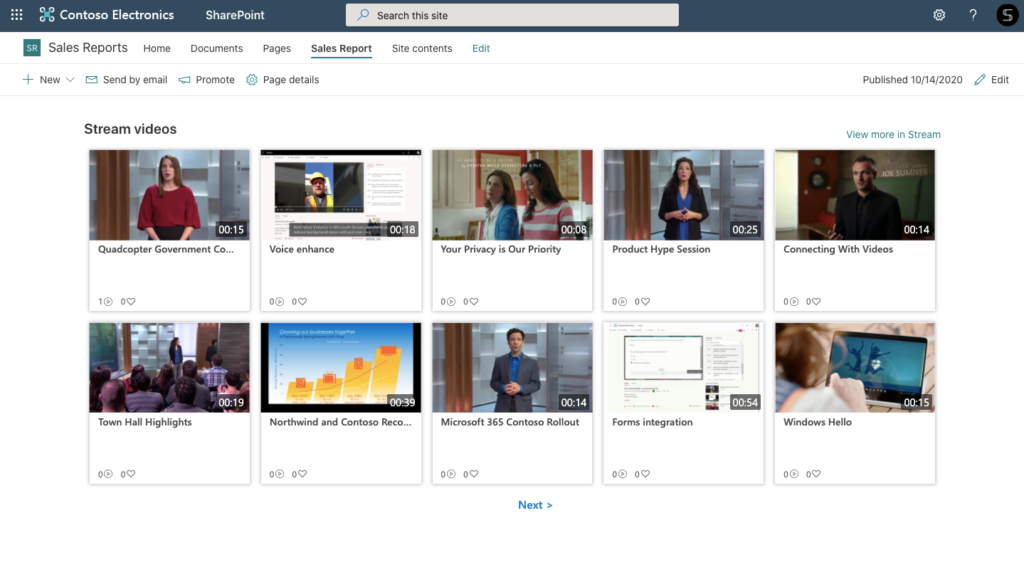
It could be recordings of meetings, training sessions, presentations, and more – everything for useful content. Once uploaded to Stream, you can use the Stream SharePoint web part to embed videos across Microsoft 365 such as SharePoint News articles and PowerPoint presentations.
Communities Yammer in your SharePoint Sites
One more example of the ideal collaboration of SharePoint with other Microsoft apps is the ability to add Yammer Conversations right to the SharePoint Online web part. This means that viewers can engage in the conversation without leaving SharePoint. You can start the conversation with any type of post and mark the best answers directly from SharePoint.
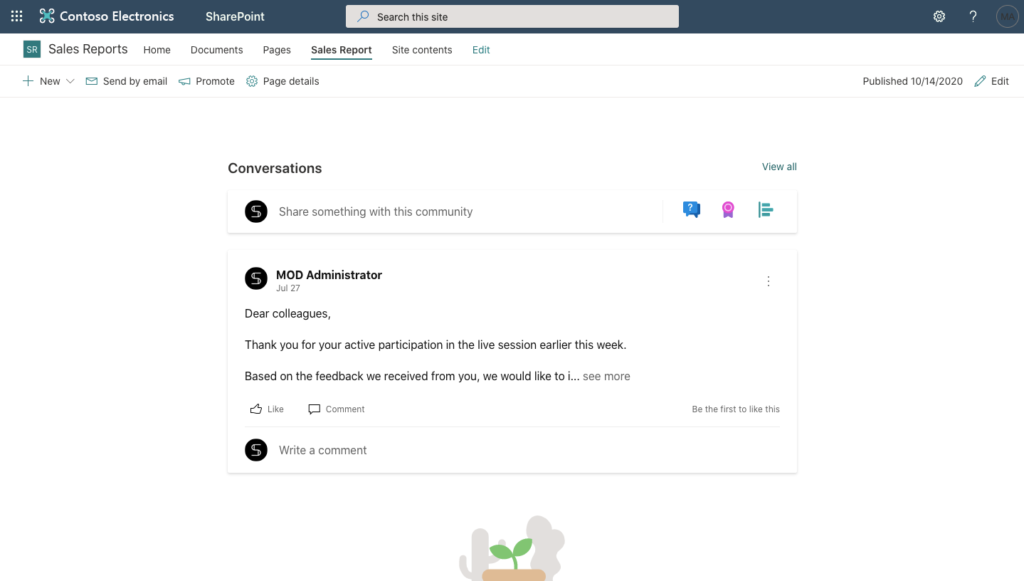
In addition, in SharePoint, you can use the Yammer to add a group, user, needed topic, or Yammer home feed.
Thus, your colleagues will communicate on relevant projects, topics, and deal without loss of information. Learn how to include a Yammer Feed into a SharePoint Site.
Microsoft Lists with SharePoint
Microsoft Lists is a collection of any data that you can share with any person in your organization. You can create lists in Lists app, Microsoft Teams, and in SharePoint. Let’s talk about the last one in details.
Click on +New on the Site content page and choose List. Next, you can create your own blank list, export it from Excel or use templates, such as:
- Issue tracker to store information about specific issues and track their progress.
- Employee onboarding to simplify the onboarding process and structure the tasks for a new employee.
- Work progress tracker to manage project planning and stay focused on important tasks.
- Content scheduler to provide visual views to your schedule and meet deadlines, and much more.
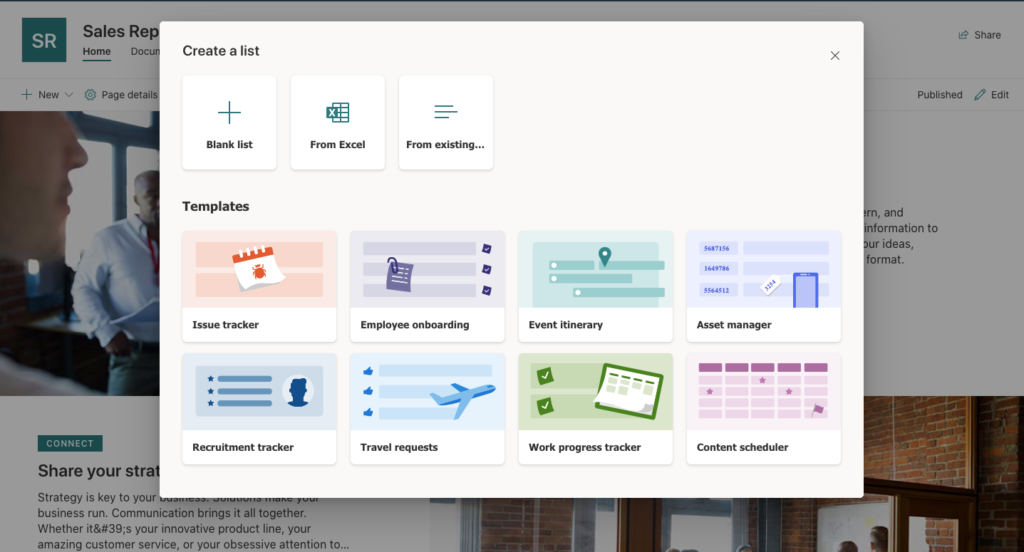
After editing, your lists will be added to your SharePoint Site. Thus, everyone who has access will see your new list with structured information. Learn how to create your first SharePoint List,
Microsoft Power Apps
So, you’ve created your first SharePoint List. What else can you do? You’re can create a new PowerApps from your SharePoint Online List. Power Apps is a software that allows you to build and use custom business apps to connect your data across the web and mobile without expensive software development.
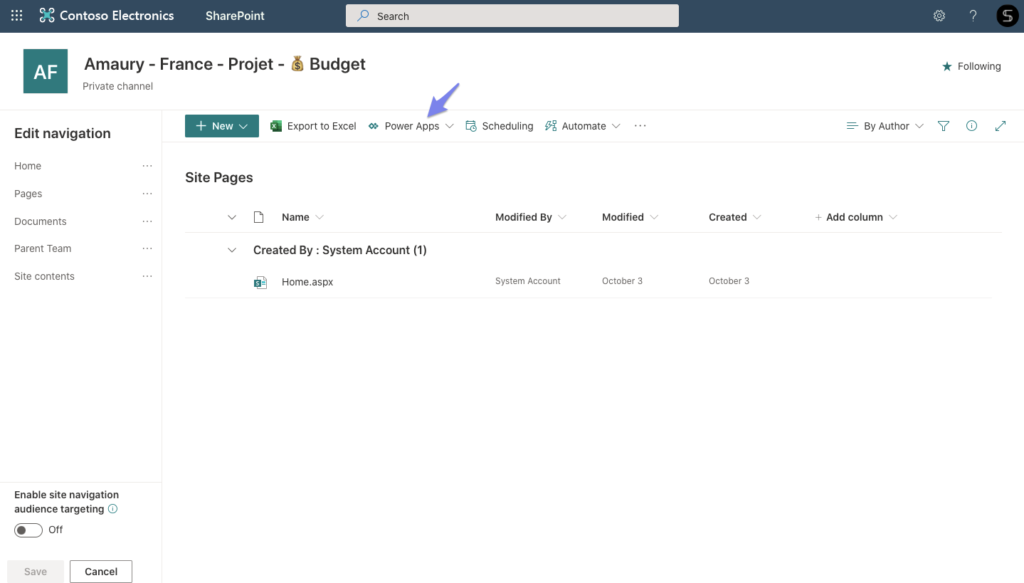
With a SharePoint list view, you can find an option to create a PowerApps for this list. Choose the needed content and the PowerApps web designer will automatically create a default app based on the data of lists. You can customize the app according to your needs with PowerApps Studio.
After creation, you can share a custom and mobile-optimized views of your existing list with your colleagues. Read more.
Power Automate with SharePoint
Power Automate is a software you use for streamlining repetitive tasks. You can use Flow templates or build your own to automate processes and save your time.
For example, you can automatically send a customized email when a new SharePoint Lists or file is added.
You can also save your email attachments to a SharePoint document library.
Created a new PowerApps? You can use flow to automatically upload a photo to SharePoint from PowerApps.
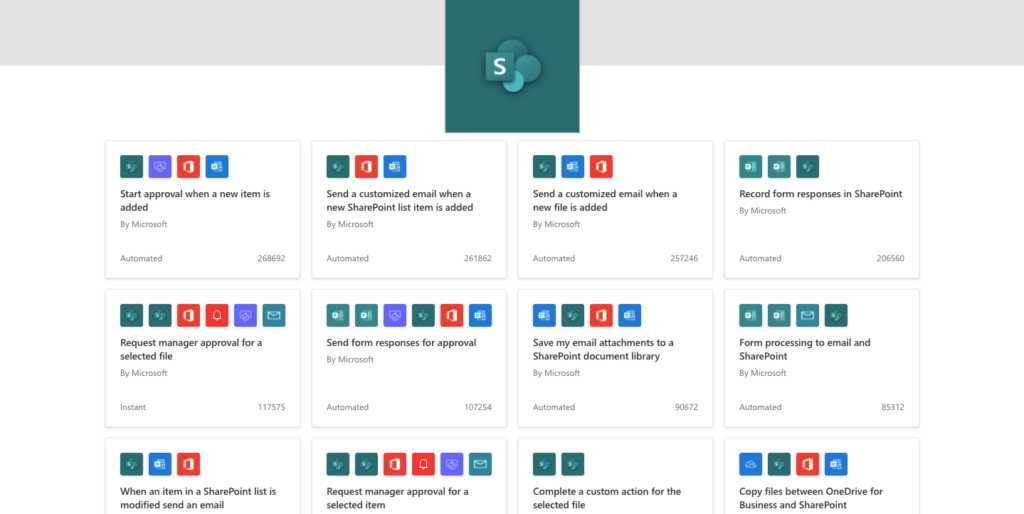
Indeed, there are so many possibilities to automate your processes between different software such as SharePoint, Outlook, OneDrive, Planner, Microsoft Teams, etc. Explore all Flow Templates or create your one.
SharePoint with Microsoft Teams
Let’s look at another possible collaboration between SharePoint and Microsoft Teams. Both apps help you work collaboratively across the entire organization. And they represent the ideal duo for those who value structured document exchange and timely news tracking.
As you may know, Microsoft Teams is a great software where users can share news, documents, discuss and host video conferences through teams and business channels. In our opinion, an indispensable feature is the ability to integrate any of Microsoft or third-party applications directly into your Teams environment. Integration with SharePoint is no exception.
Document sharing
Before talking about the possibilities of integrating the apps, it is necessary to understand the basis of their joint work. The main detail here is that as part of Office 365, Microsoft Teams and SharePoint are already working together without you. How is this possible? It’s very simple – all documents that you create, upload and sync in Teams are automatically stored in the SharePoint Library. Indeed, if you are actively working in Teams, try to open SharePoint – you will see automatically generated sites containing all your documents depending on the affiliation to a particular channel.
An important point where we wanted to highlight is the naming. As you may know, the names of the sites you create in SharePoint automatically include the name of your organization in Office 365. How do your Team documents sync in SharePoint? Look at this image to see how you can distinguish between documents and files depending on the channel or group in which they were created.
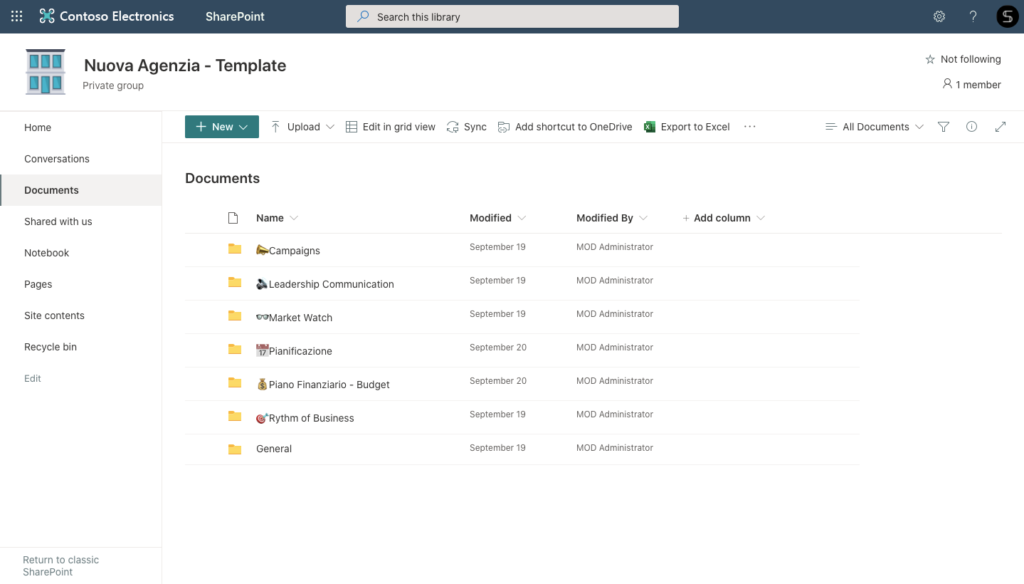
In fact, the collaboration between Teams and SharePoint ideally allows users to work with documents without information loss, duplication, and miscommunication.
In addition, it is very convenient to work between the two applications. For example, you don’t have to leave Tims to work on files, they appear in the Files tab. Also, you can find an option “Open in SharePoint” which will take you directly to the Site.
News and Conversations
To improve the user experience of Microsoft Teams, you can add SharePoint sites directly to the tabs in the needed channel. So, right in the Teams channel, users will be able to follow your Site containing the necessary information.
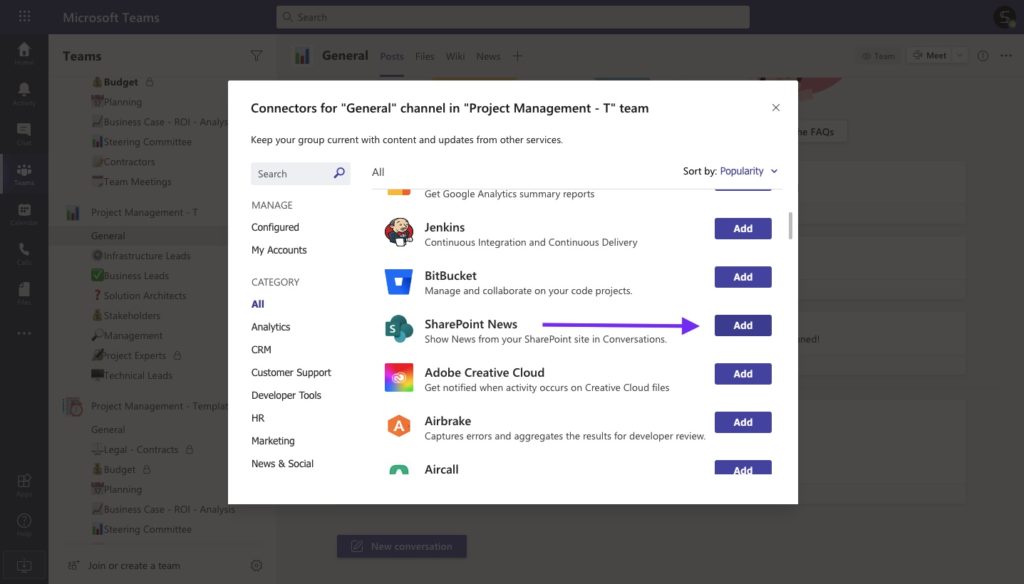
Here it is even possible to include not only the site but also the whole document located in SharePoint Library. Just imagine the necessary presentation, guide, or instruction without the need for a search, right in the channel tab in online access for the entire team
Next, you can add news published on the SharePoint site directly to the post in Teams. So, together with the team, you can discuss a relevant topic and stay up to date with the latest news in the organization. In the same way, you can create a conversation around any document from your SharePoint Library.
Creating teams from SharePoint
Finally, the integration of Microsoft Teams and SharePoint allows you to reduce the time for creating teams. For example, when creating a new team, instead of adding members manually, you can select the function “Create a team from an exciting Office 365 group”. As a result – a ready-made team directly from the group of a specific Site
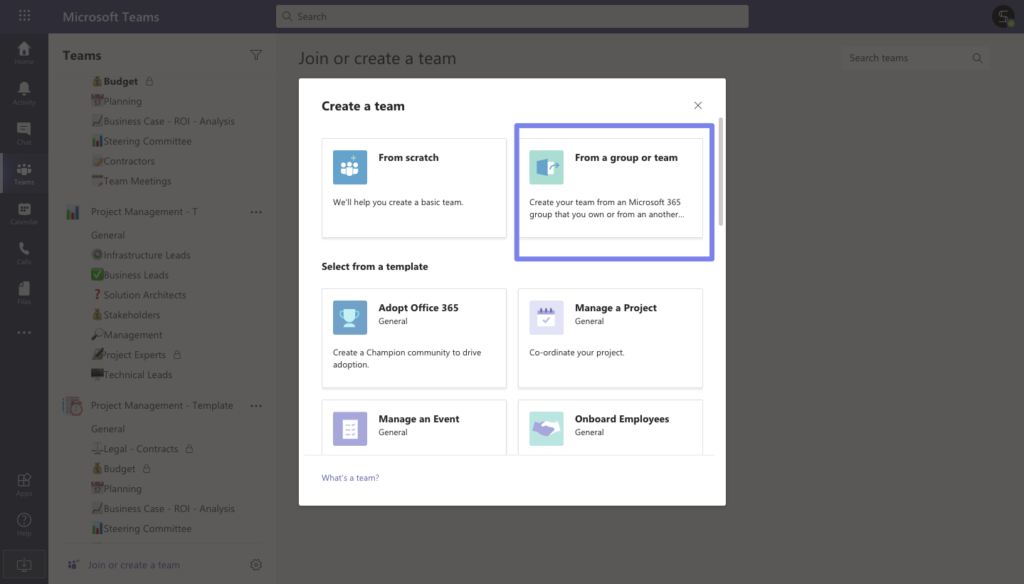
Above, we examined some of the integration options for SharePoint and Teams. Indeed, both applications complement each other perfectly and allow users to quickly and efficiently solve any work issues without leaving the familiar interface.
Microsoft Teams Templates
At the same time, users often face some problems when using Teams. These include:
- The need to devote most of the work time to create a workspace with channels and teams
- Uncontrolled creation of collaboration silos. This is because employees can create an unlimited number of teams, which leads to a heavy load on the information department, confusion, and unsystematic naming. The latter, in turn, can lead to problems with the storage and exchange of files, especially in large organizations.
- Difficult interface. The uncontrolled creation of teams and channels ultimately leads to a misunderstanding of employees where it is necessary to share information and, as a result, to miscommunication and loss of important information.
The above problems can be solved by creating Teams templates. This allows the organization to create pre-built templates with included channels that the end-users will understand. It is very easy for users to create teams with already built communication channels. This way you can solve both problems – provide a ready-made workspace and control the creation of teams.
Advanced Templates with SharePoint
At SalesTim we can offer you even more. Template technology allows you to create teams from templates with included channels, copied files, tabs, settings, and members. Sounds interesting? Let’s look at a few use cases examples of how you can effectively apply our technology even in integration with SharePoint.
Let’s imagine that you need to work with your team for the next project. Instead of manually creating a team for specific projects each time, you once create a template with ready-made relevant channels, for example:
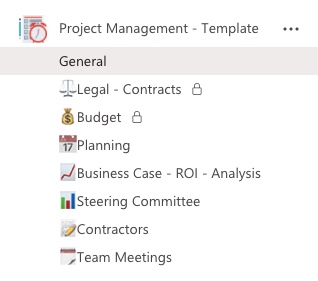
- Budget
- Planning
- Business Case
- Contractors
In the files Tab, you synchronize all the necessary documents from your site in SharePoint. In addition, you add to the tab in the KPI channel a report that was created using BI on one of the sites in your SharePoint
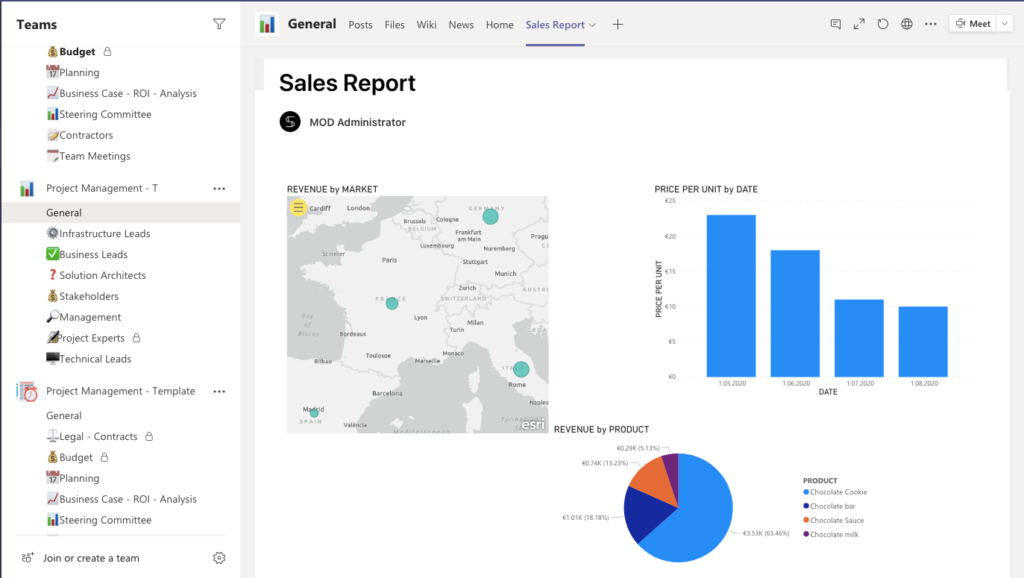
After, you add the template to the templates catalog. The next time your project manager needs to start a new project, he will create a team from a ready to use the template in a few clicks.
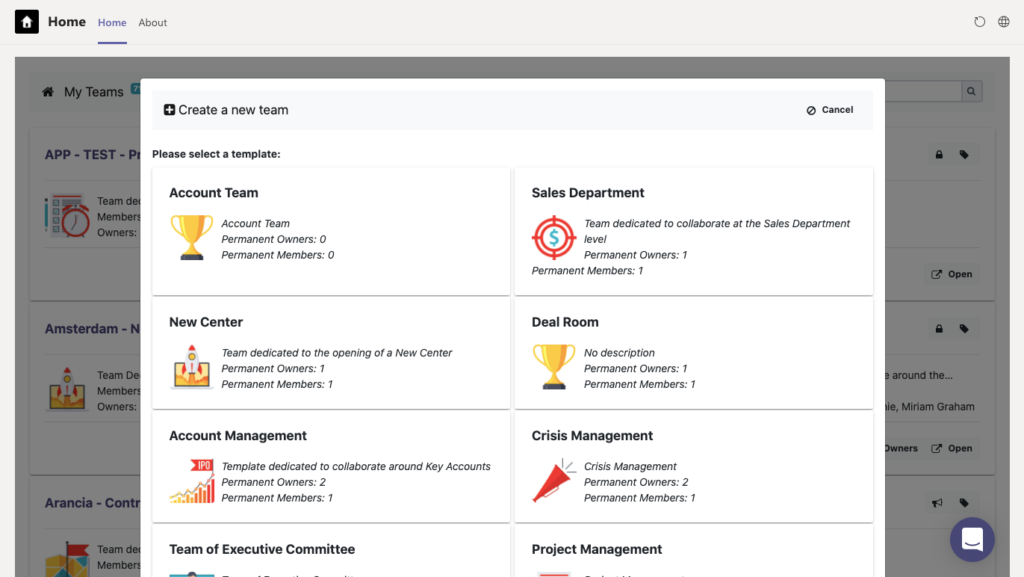
The newly created team will not only copy the channels but also all the files that you added before. This is very useful if you have added various guidelines, case studies, and instructions to your template so that project members have quick access to the necessary standards and practices.
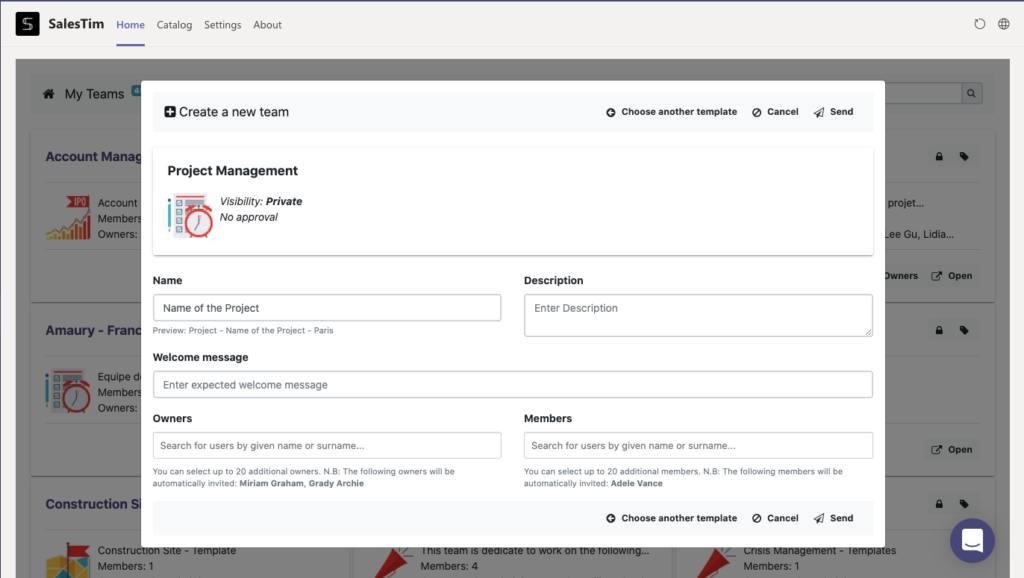
In addition, they will automatically see the report you added from SharePoint, in which they can easily track the dynamics of projects, the organization’s financial flows, and more. Pay your attention that SalesTim supports your SharePoint Sites with highlighted events, lists, and many other contents. But we do not copy your SharePoint Files or Apps into a Tab in a newly created team from your Template.
Learn more about Microsoft Teams Templates with Apps 😉
Microsoft Teams Governance
When creating templates with SalesTim, you can also easily control Microsoft Teams Governance, for example:
- Naming Convention
- Permanent Membership
- Approval Workflows and more
Let’s take a closer look at the naming convention. Remember, we talked about the name of your files synced with SharePoint? The name of the link to the file contains the name of the team and the channel in which the file was created. Imagine if your organization does not have naming rules? If users uncontrollably create teams and channels and name them at their discretion. On an organizational scale, this can be a disaster for the information department, leading to duplication and loss of important files.
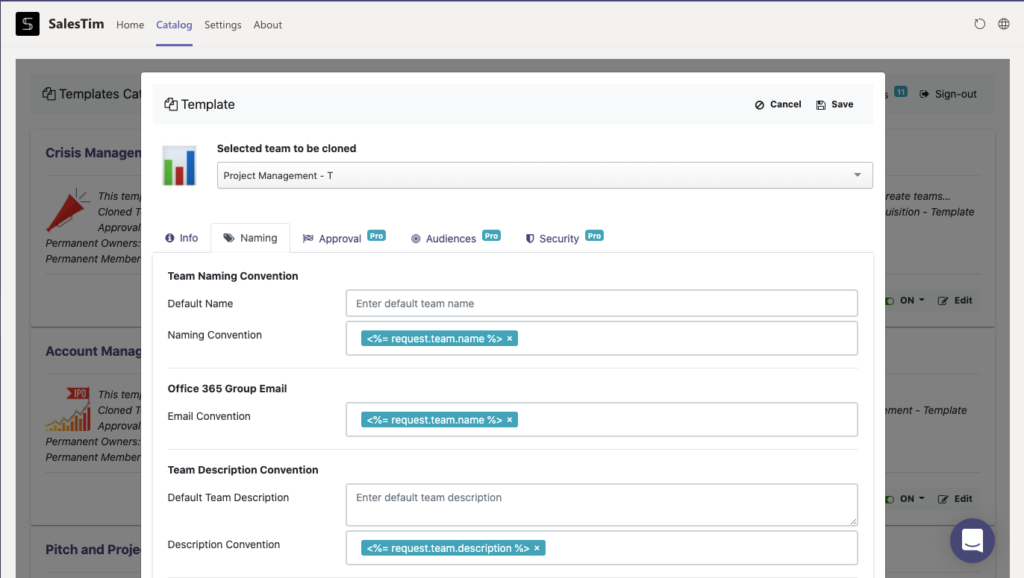
Together with SalesTim, you can easily set the naming while creating the template. So, new teams will be named according to your established rules:
- Fixed Prefix or Suffix for Static Naming Convention
- Dynamic Naming Convention based on users’ Azure AD Data
- Email Naming Convention
Learn more about the Microsoft Teams Naming Convention in our blog!
In conclusion, we would like to say that Office 365 gives users unlimited opportunities to improve collaborative work. In this article, we have covered just a few examples of how you can meet organizational needs with the collaboration of SharePoint with Microsoft Teams, as well as how you can improve the user experience with additional technologies such as SalesTim. We will be happy to help you with Microsoft Teams usage
